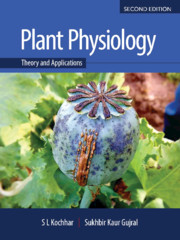Book contents
- Frontmatter
- Contents
- Foreword
- Preface to the Second Edition
- Preface to the First Edition
- Acknowledgements
- Some Common Abbreviations used in the Text
- Abbreviations for Units
- Unit I Water and Mineral Translocation in Plants
- Unit II Metabolism and Bioenergetics
- Unit III Growth and Development
- Unit IV Physiological Stress and Secondary Metabolites – Their Role in Metabolism
- Unit V Crop Physiology – An Innovative Approach
- Unit VI Breakthroughs in Plant Physiology
- Unit VII Some Experimental Exercises
- Glossary
- References
- Index
- Colour Plates
Chapter 1 - Plant–Water Relations
Published online by Cambridge University Press: 12 May 2020
- Frontmatter
- Contents
- Foreword
- Preface to the Second Edition
- Preface to the First Edition
- Acknowledgements
- Some Common Abbreviations used in the Text
- Abbreviations for Units
- Unit I Water and Mineral Translocation in Plants
- Unit II Metabolism and Bioenergetics
- Unit III Growth and Development
- Unit IV Physiological Stress and Secondary Metabolites – Their Role in Metabolism
- Unit V Crop Physiology – An Innovative Approach
- Unit VI Breakthroughs in Plant Physiology
- Unit VII Some Experimental Exercises
- Glossary
- References
- Index
- Colour Plates
Summary
Water – A Universal Solvent
Water is the most abundant resource for nearly all organisms. Covering over 70 per cent of the earth's surface and making up as much as 95 per cent of the matter of living organisms, it is virtually unique among all liquids. The water content of plants is in a continuous state of flux, based on the degree of metabolic activity, the water status of the surrounding air and soil, and a variety of other factors.
Water plays a crucial role in the physiological processes of plants; roles for which it is wellsuited because of its special physical and chemical properties, some of which are:
• Water is an excellent solvent, making it a suitable medium for the absorption and translocation of mineral elements and other solutes necessary for normal plant growth and development.
• Most of the ‘biochemical reactions’, that are so characteristic of life, occur in water and water itself participates directly or indirectly in all the metabolic reactions.
• The ‘thermal properties’ of water, i.e., high specific heat, high latent heat of vaporization and high heat of fusion, ensure that water remains in the liquid form over the range of temperatures where most biological reactions take place.
• The combined properties of ‘cohesion’ (capacity to bind strongly with itself), ‘adhesion’ (capacity to bind strongly with other molecules containing oxygen such as glass and cell walls) and ‘tensile strength’ (a measure of the maximum tension a material can withstand before breaking) are especially significant for maintaining the continuity of water columns in plants.
• The ‘transparency’ of water facilitates penetration of sunlight into the aqueous medium of cells thus enabling photosynthesis and other physiological processes to function in the cells.
These properties derive primarily from the ‘polar’ structure of the water molecule (Figure 1.1a). The water (H2O) molecule (molecular weight, 18) is composed of an oxygen atom covalently bonded to two hydrogen atoms that are attached asymmetrically to one side. The two O−H bonds form an angle of 104.5° rather than 180°.
- Type
- Chapter
- Information
- Plant PhysiologyTheory and Applications, pp. 3 - 50Publisher: Cambridge University PressPrint publication year: 2020



